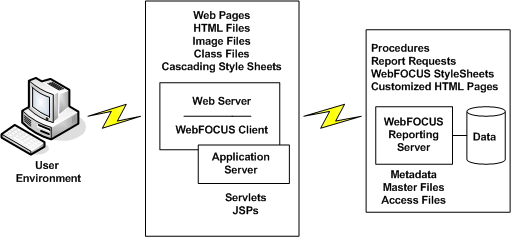Reference: Partitioned Application Files and Servers
The following diagram illustrates how all user interface logic and data access logic can be configured behind multiple firewalls for maximum security.

The web server processes the webpages that provide the presentation logic for a WebFOCUS reporting application. The web server accesses HTML files, graphical image files, and Java class files, and Cascading Style Sheets. For more information about how to specify file locations on the web server, see the WebFOCUS installation guide for your platform.
The application server provides the user interface logic for your WebFOCUS tools, and is the location for servlets, JSPs, and Java Beans. Having an application server to process application logic behind the user interface provides performance and security benefits.
WebFOCUS does not provide an application server. You can use a third-party server, such as WebLogic, WebSphere, Tomcat, Apache, or Netscape.
The Application server resides separately or together with the web server.
The WebFOCUS Reporting Server processes the procedures containing the user interface logic for reports, as well as the files that contain metadata for the data sources. Stored on the WebFOCUS Reporting Server are report requests, WebFOCUS StyleSheets, customized HTML pages called from WebFOCUS procedures, and Master and Access Files.
The WebFOCUS Reporting Server also accesses the data sources used by an application.